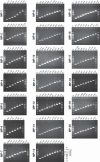Escherichia coli O-Genotyping PCR: a Comprehensive and Practical Platform for Molecular O Serogrouping
- PMID: 25926488
- PMCID: PMC4508431
- DOI: 10.1128/JCM.00321-15
Escherichia coli O-Genotyping PCR: a Comprehensive and Practical Platform for Molecular O Serogrouping
Abstract
The O serogrouping of pathogenic Escherichia coli is a standard method for subtyping strains for epidemiological studies and enhancing phylogenetic studies. In particular, the identification of strains of the same O serogroup is essential in outbreak investigations and surveillance. In a previous study, we analyzed the O-antigen biosynthesis gene cluster in all known E. coli O serogroups (A. Iguchi et al., DNA Res, 22:101-107, 2015, http://dx.doi.org/10.1093/dnares/dsu043). Based on those results, we have arranged 162 PCR primer pairs for the identification or classification of O serogroups. Of these, 147 pairs were used to identify 147 individual O serogroups with unique O-antigen biosynthesis genes, and the other 15 pairs were used to identify 15 groups of strains (Gp1 to Gp15). Each of these groups consisted of strains with identical or very similar O-antigen biosynthesis genes, and the groups represented a total of 35 individual O serogroups. We then used the 162 primer pairs to create 20 multiplex PCR sets. Each set contained six to nine primer pairs that amplify products of markedly different sizes. This genetic methodology (E. coli O-genotyping PCR) allowed for comprehensive, rapid, and low-cost typing. Validation of the PCR system using O-serogroup references and wild strains showed that the correct O serogroups were specifically and accurately identified for 100% (182/182) and 90.8% (522/575) of references and wild strains, respectively. The PCR-based system reported here might be a promising tool for the subtyping of E. coli strains for epidemiological studies as well as for the surveillance of pathogenic E. coli during outbreaks.
Copyright © 2015, American Society for Microbiology. All Rights Reserved.
Figures


References
-
- Penner JL, Aspinall GO. 1997. Diversity of lipopolysaccharide structures in Campylobacter jejuni. J Infect Dis 176(Suppl):S135–138. - PubMed
Publication types
MeSH terms
Substances
LinkOut - more resources
Full Text Sources
Other Literature Sources

